Sherab Lhamo
2023 was the warmest year in 174 years, even warmer than what was recorded as the warmest years in 2016 and 2020, according to the World Meteorological Organization (WMO).
The global mean near-surface temperature was around 1.40°C above the 1850–1900 baseline.
In Bhutan, Phuentsholing recorded the highest daily maximum temperature at 38.5°Celsius, whereas, Haa recorded the lowest daily minimum temperature at -10.5°Celsius, according to Bhutan State of Climate (BSC) 2024. BSC, published by the National Centre for Hydrology and Meteorology (NCHM), an annual climate monitoring report that provides a summary of observations of the country’s climate each year.
The report stated that Haa experienced a greater number of days (135) with the minimum temperature below or equal to zero.
Meteorological stations such at Sipsu in Samtse, Phuentsholing, Bhur in Sarpang, Punakha and Bajo in Wangdue experienced higher annual average of 29.88°Celsius maximum temperatures, while Haa, Gasa, Paro and Chamkhar in Bumthang stations recorded lower annual average maximum temperatures of 16.28°Celsius.
The International Panel on Climate Change’s sixth Assessment report stated the average of 1.19 (1.07 – 1.31) °C for the 10-year period between 2014 – 2023 showed continued warming in the world.
According to the Bhutan climate change tracker for 2020, it’s projected that between 2020 and 2030, temperatures would rise by 2 degrees Celsius, surpassing the Paris Agreement’s target of limiting the increase to 1.5 degrees Celsius.
Meanwhile, the annual average rainfall in Bhutan was 1794.30 mm in 2023, slightly below normal rainfall against the long-term average from 1996 to 2022.
The highest total annual rainfall was recorded at Phuentsholing with 6,549.10 mm, Sipsu under Samtse with 5604.10 mm followed by Bhur under Sarpang with 5,376.20 mm.
Bhur recorded the highest rainfall in 24-hours with 306.0mm. Gasa recorded the highest number of rainy days at 200 days, however, the highest number of rainy days did not correlate with greater accumulated rainfall.
The Southern part of the country received more rainfall compared to other regions.


